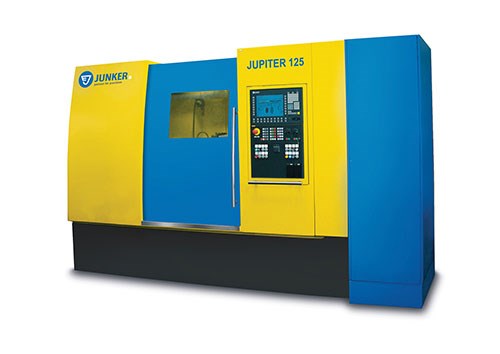Faster Setup for Centerless Grinders
The new series of Jupiter centerless cylindrical grinding machines from Erwin Junker Machinery (Elgin, Illinois) addresses the limitations to applying this process to small- to medium-sized batches.
Centerless cylindrical grinding is fast, precise and productive, especially for manufacturing small, long or slender workpieces. However, setting up or retooling the typical centerless machine can require many hours from a skilled operator, often relying on experience and intuition “to get it right.” For this reason, the process generally has been favored for high-volume applications, and less so for small- to medium-sized batches.
The new series of Jupiter centerless cylindrical grinding machines from Erwin Junker Machinery (Elgin, Illinois) addresses this limitation. A height-adjustable work rest blade and control software to establish exact blade position were developed by the company’s parent in Germany. These developments shorten setup, thereby reducing the time required to produce the first good part. The machines in this series (the Jupiter 125, 250 and 500) are capable of straight (through-feed) and angular plunge-cut grinding.
Angular grinding is required for any part on which shoulders are ground, including workpieces recessed with different diameters. To make this grinder particularly suitable for high-precision applications, the company combined both grinding operations in a single machine. The regulating wheelhead can be pivoted horizontally and has a permanently affixed work rest blade. During grinding, the regulating wheel presses the part against the grinding wheel profile at an angle. This also makes it possible to grind highly complex parts with multiple recesses. The grinding wheelhead is designed to be rigid and has just one infeed axis.
The height-adjustable work rest blade is a programmable feature that comes with special control software to automatically calculate the optimum position of the blade. These calculations are based on preset parameters derived from the manufacturer’s testing and research, and the axes are aligned according to resulting input values. These calculations are designed to fill in for a skilled operator’s intuitive estimations and trial-and-error adjustments.
As the regulating wheel wears down, both the position of the regulating wheel and the work rest blade are automatically reset by adjusting the height of the blade. The Junker control electronics accomplish this compensation with corresponding tracking of the grinding and regulating wheel, thus ensuring precise, consistent grinding at all times. Following each dressing process, the position is automatically recalculated and the grinding wheel corrected. The quality of the concentricity remains constant while requiring less time to adjust the centerless grinding process without compromising performance, the company says.
A top engineer at Junker’s technology center in Germany explains why the centerless method is complicated: “During grinding, the regulating wheel diameter decreases. This changes the angles; that is, the contact angle of the regulating wheel and the angle to the work rest blade,
resulting in different contact points. So as the wheel wears down, different angles are produced, and the roundness gets worse.” Existing software that compensates for these changes generally sets the process more or less in the middlebetween minimum and maximum wear, he says. In an application that requires roundness values of a few tenths of a micron, this compromise is often inadequate.
“At best, you can get down to an accuracy of one or two microns,” he says. “The reason a traditional centerless machine is so hard to set up is that you never really know exactly how high up the part is positioned in the machine. With electronic height adjustment of the work rest blade, we can make the contact angles constant along the entire wear zone of the regulating wheel and the grinding wheel. Once you have a good angle setup, it stays that way.”
During the grinding process, the work rest blade can still be adjusted. For example, it’s possible to set a different height for both rough grinding and finish grinding. “With centerless grinding, we’re also talking about the magic triangle between the workpiece center and the contact points of the grinding and regulating wheels,” explains the technologist. “The distances in this imaginary triangle determine the roundness, and in the end, they make for the final quality of the part.”
Applications for the Jupiter 125 include fuel injection components or very precise transmission parts with shoulders and tightly toleranced radius transitions, as well as fine grinding of needles for bearings and hydraulic pistons. For larger parts, the Jupiter 250 and 500 models are available with comparable features and capabilities.
Related Content
Grinding Wheel Safety: Respect The Maximum Speed
One potential source of serious injury in grinding comes from an oversight that is easy to make: operating the wheel in an over-speed condition.
Read MoreInside an Amish-Owned Family Machine Shop
Modern Machine Shop took an exclusive behind-the-scenes tour of an Amish-owned machine shop, where advanced machining technologies work alongside old-world traditions.
Read MoreChoosing Your Carbide Grade: A Guide
Without an international standard for designating carbide grades or application ranges, users must rely on relative judgments and background knowledge for success.
Read MoreA New Milling 101: Milling Forces and Formulas
The forces involved in the milling process can be quantified, thus allowing mathematical tools to predict and control these forces. Formulas for calculating these forces accurately make it possible to optimize the quality of milling operations.
Read MoreRead Next
The Cut Scene: The Finer Details of Large-Format Machining
Small details and features can have an outsized impact on large parts, such as Barbco’s collapsible utility drill head.
Read More3 Mistakes That Cause CNC Programs to Fail
Despite enhancements to manufacturing technology, there are still issues today that can cause programs to fail. These failures can cause lost time, scrapped parts, damaged machines and even injured operators.
Read More.jpg;maxWidth=970;quality=90)











.jpg;maxWidth=300;quality=90)

















